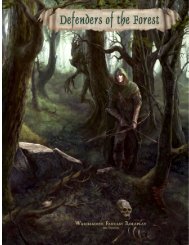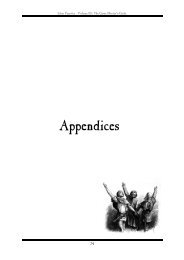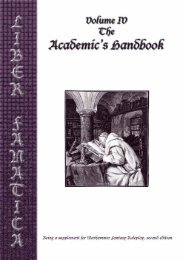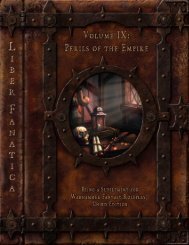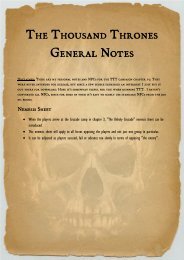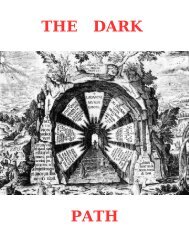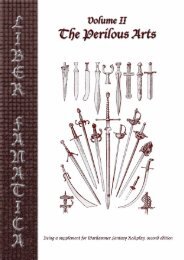Download Here (5.27 MB) - Liber Fanatica
Download Here (5.27 MB) - Liber Fanatica
Download Here (5.27 MB) - Liber Fanatica
You also want an ePaper? Increase the reach of your titles
YUMPU automatically turns print PDFs into web optimized ePapers that Google loves.
<strong>Liber</strong> <strong>Fanatica</strong> - Volume III : The Game Master’s Guide<br />
Handling Horror and Insanity<br />
by James Walkerdine<br />
S<br />
ome players and GM’s like their WFRP games<br />
to have a strong dose of horror. Indeed the<br />
published material seeks to encourage this with<br />
the notion of Sanity points and the long list of<br />
possible mental disorders. Horror can be fun; it’s<br />
human nature to get a kick out of being scared<br />
(as long as it’s not real!) which is why horror<br />
stories and films are always popular. Horror<br />
within roleplaying can bring other dimensions of<br />
enjoyment to a game.<br />
These little descriptions help to set the tone,<br />
allow the players to jump to conclusions, and<br />
most importantly sow the seeds of fear. Obviously<br />
there is a fine line on how far you can push this.<br />
Just as an encounter can be ruined by not<br />
building up enough atmosphere, the same can be<br />
true if it is stretched out for too long. Keep the<br />
momentum going and if it looks like the players<br />
are starting to get complacent or bored, bring the<br />
encounter to its peak.<br />
This article discusses ways in which a GM can<br />
bring horror into their games, and shows how to<br />
handle one of the side-effects of experiencing<br />
such horror - insanity.<br />
Handling Horror<br />
The key to successfully presenting horror within<br />
a roleplaying game is in building up the right<br />
atmosphere. If the GM manages to pull this off<br />
then the players’ imaginations will do the rest –<br />
hearts will pound, brows will sweat and genuine<br />
fear will start to develop. Those who have played<br />
games like Call of Cthulhu will probably be<br />
already familiar with this style of play. In fact the<br />
various stories concerning the Cthulhu Mythos 1<br />
can provide a good source of ideas on how to<br />
create the right atmosphere as well as offering<br />
ideas for plots and cultists. For those without<br />
access to this material, a number of ideas are<br />
presented here 2 . Simple examples are provided to<br />
illustrate the various points.<br />
It should be noted, however, that GMing horror<br />
doesn’t have to be solely based around using<br />
shock and awe techniques, but can be much<br />
more subtle and long term. Rather than a<br />
fearsome creature that rips off player character<br />
limbs for fun, it can equally be as horrific for a<br />
character to discover that he is slowly mutating<br />
over a couple of months. If anything, combining<br />
or fluctuating between different horror styles is<br />
often the best way to create a more complete<br />
horror atmosphere and one that never becomes<br />
too repetitive.<br />
Slow but steady – it’s much more dramatic to<br />
build up the atmosphere gradually, rather than<br />
having the horrific encounter happening all at<br />
once. Start the encounter off slowly and lay the<br />
foundations by providing small descriptions of<br />
what the characters experience around them.<br />
Example: A group of adventurers are on the track<br />
of a fearsome creature that has been terrorising<br />
the surrounding area. They have managed to<br />
discover its lair and have begun to explore. The<br />
GM wants to make this a scary experience for the<br />
players, so as they explore the lair he provides<br />
small descriptions of the environment around them<br />
every so often.<br />
“As you approach the corner you can faintly make<br />
out a strange gurgling sound from beyond.”<br />
“You rest your hand against the wall and find that<br />
it’s cold and clammy, sticky to touch.”<br />
“On closer inspection the corpse looks like it has<br />
been mauled but, perhaps more disturbingly, the<br />
hole in the head gives the impression that<br />
something burst out from within…”<br />
Exploit the senses – characters possess a range<br />
of perceptions; make sure you feed information to<br />
all of them! As well as what they can see,<br />
describe what they can hear, smell and touch,<br />
senses that often get underused within a<br />
roleplaying game. GM’s can take this even further<br />
and exploit a character’s dreams. Horrific<br />
nightmares that foreshadow events or a location<br />
the characters are set to visit can act as powerful<br />
means for stoking up fear within the players!<br />
Example: The adventurers are making their way<br />
deeper into the lair. The GM is still having fun…<br />
“As you make your way down the passageway<br />
you are all suddenly overcome by the sickly<br />
stench that seems to emanate from up ahead.<br />
Everyone make Toughness tests, those who fail<br />
find their stomachs go into spasms as they wretch<br />
uncontrollably.”<br />
“Okay Jack, you stop to listen – it is silent apart<br />
from your own breathing. Slowly you become<br />
aware of a second breathing sound, close by and<br />
matching your own. As you strain to hear where<br />
exactly it’s coming from you feel breath cold as the<br />
tomb on the back of your neck…”<br />
1 There are various collections of Lovcraft’s stories in<br />
existence, and also collections of Mythos stories written<br />
by other authors such as Ramsey Campbell and<br />
Stephen King.<br />
2 Another good reference is "Nightmares of mine", a<br />
book on roleplaying horror RPGs, written by Ken Hite.<br />
12



